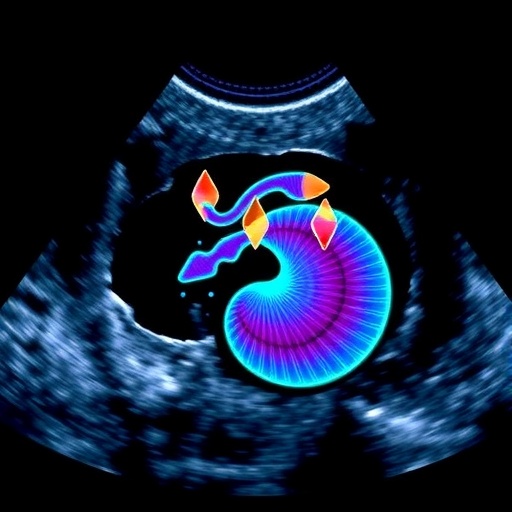For the first time in medical imaging, a team of Inserm researchers affiliated with the Physics for Medicine Institute (Inserm/ESPCI Paris-PSL/CNRS) has unveiled a groundbreaking ultrasound technology capable of mapping blood flow within an entire organ in remarkable detail. This breakthrough imaging method delivers four-dimensional data—capturing three-dimensional spatial information continuously over time—thereby providing an unprecedented view of the complex vascular networks that sustain organ function. The research, recently published in the high-impact journal Nature Communications, reveals how this technology could revolutionize our understanding of microcirculation and markedly advance the diagnosis and monitoring of cardiovascular and microvascular diseases in clinical settings.
Blood microcirculation comprises an intricate network of vessels, including tiny arterioles, capillaries, venules, and lymphatic channels, which collectively deliver oxygen and nutrients to tissues while removing metabolic waste. Traditional imaging modalities have struggled to capture the entire vascular architecture at micro scales, especially within large organs, due to technical challenges involving spatial resolution and temporal resolution. Existing methods are typically limited either to superficial vessels or small organ slices, impeding comprehensive functional assessments of blood flow dynamics across the whole organ.
Responding to these limitations, Inserm scientists developed an innovative multi-lens ultrasound probe during Nabil Haidour’s doctoral research, supervised by Clément Papadacci. This probe is designed to penetrate deep into living tissue, capturing vascular networks at scales smaller than 100 micrometers. Notably, the team successfully demonstrated this technology in vivo in sizable animal models with organ dimensions closely resembling those of humans. The researchers achieved detailed maps of blood circulation within the heart, kidney, and liver, capturing both the structural complexity and time-dependent flow kinetics with unmatched clarity and consistency.
The power of this methodology lies partly in its ability to visualize not only large vessels but also the finest microvessels distributed throughout organ tissue, a feat unattainable by previous ultrasound or even advanced optical techniques. In the liver, for instance, the technology discerned the distinct blood supply routes — arterial, venous, and portal venous systems — by identifying their unique hemodynamic signatures. This capability to distinguish overlapping vascular networks within a single organ could empower clinicians and researchers to unravel the subtleties of organ physiology as well as pathophysiological changes associated with disease.
Clément Papadacci, the lead author of the study, emphasized the novelty and clinical promise of this technology, stating, “The originality of these results lies in the fact that these images allow us to visualize the vessels of an entire organ at very small scales — less than 100 micrometers — providing unprecedented four-dimensional resolution. This enables observation of the entire large organ and its blood flow dynamics in real time.” Such detailed insight into vascular microarchitecture and functionality could provide new biomarkers for early detection of diseases that disrupt microcirculation.
Importantly, the ultrasound-based approach is entirely non-invasive, circumventing risks and complications associated with contrast agents or ionizing radiation commonly used in other imaging modalities like MRI or CT scans. Additionally, this method boasts the potential for portability; the probe can be connected to compact, mobile equipment. This portability is envisioned to ease integration into everyday clinical workflows, allowing for rapid bedside or outpatient evaluation of vascular health without demanding substantial infrastructure investment.
Building on the robust preclinical results, the team is moving forward with clinical trials to validate the technique in human subjects. The development is also supported by the Technological Research Accelerator for Biomedical Ultrasound, an Inserm initiative integrated into the Physics for Medicine Institute that fosters innovation in ultrasound technologies. These efforts aim to refine the imaging hardware and software, optimize imaging protocols, and establish standardized metrics for clinical interpretation.
The anticipated clinical impact of this technology extends beyond pure visualization. It holds promise for diagnosing complex microvascular disorders that presently elude definitive detection. Diseases such as heart failure, chronic kidney disease, and various systemic conditions can profoundly alter microcirculation but are challenging to characterize fully with current tools. This ultrasound approach could offer a new quantitative framework to assess small vessel integrity and flow dynamics, facilitating earlier intervention and better tracking of therapeutic efficacy.
Furthermore, the ability to monitor vascular function in dynamic 4D offers unique opportunities for research into organ physiology and pathology. Time-resolved data on blood flow patterns could illuminate mechanisms of disease progression in real time and aid in the development of targeted treatments. As research progresses, this imaging platform might also be adapted for a broad spectrum of organs and vascular conditions, potentially transforming vascular medicine.
Summarizing the broader vision, Clément Papadacci concludes, “Used in clinical settings, this new technology could become a major tool for better understanding vascular dynamics as a whole—from the largest vessels to the pre-capillary arterioles. It could also help advance the diagnosis of microcirculation disorders and monitoring of treatments for small vessel diseases, which are notoriously complex to diagnose and typically identified only after excluding other pathologies.”
In essence, this pioneering ultrasound imaging technology opens a new frontier in the study and clinical assessment of microvascular networks. By bridging the gap between macroscopic vessel imaging and microscopic capillary resolution with temporal precision, it answers a longstanding biomedical challenge. As the technology moves towards human application, it has the potential to become indispensable in the future landscape of personalized vascular health management.
Subject of Research:
Innovative ultrasound imaging of whole-organ microvascular blood flow dynamics
Article Title:
Multi-lens ultrasound arrays enable large scale three-dimensional micro-vascularization characterization over whole organs
News Publication Date:
28-Oct-2025
Web References:
DOI:10.1038/s41467-025-64911-z
Keywords:
Health and medicine, ultrasound imaging, microcirculation, vascular dynamics, non-invasive imaging, microvascular diseases




